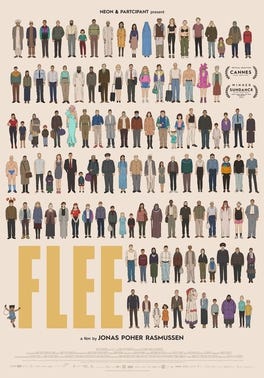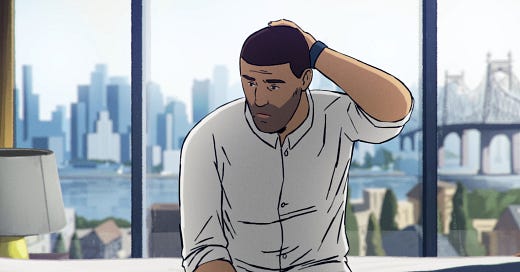
Flee (2021). Grade: A-
So we have these Danish friends. When Mrs. twinsbrewer left home for college, her dad got Empty Nest Syndrome and hosted a Danish exchange student; this worked well, so each summer, he’d have another one. Mrs. twinsbrewer stayed in touch with three of them. They live in different parts of Denmark, and have the fancy professions you’d expect from global sophisticates like ourselves; house painter, garage-door installer, Navy NCO.
Every five years or so, we’d go visit them (when we were younger and less cash-strapped). On one visit, we were shocked to hear one of our friends spouting inane anti-Muslim, anti-immigrant gibberish. (While their dad and brother rolled their eyes; clearly this was a familiar Rant.) “They spit on police officers! They burn THE BIBLE!”
“What do you care? You’ve never opened a Bible in your life. You told us that most Danes only go into a church three times; when they’re baptized, when they’re married, and at their funeral.”
“Maybe so, but these immigrants aren’t trying to respect our culture.”
On the same trip, another Danish friend (who IS a devout Christian) said he heard this stuff, too — it came from right-wing politicians, and had no basis in reality. (Surprise!) He said most immigrants do pretty well at assimilating, despite the obstacles. They tend to be placed in poor, concentrated neighborhoods. And while learning spoken Danish isn’t too hard (according to him), it’s really tricky to pick up the written version; it has a mixture of both modern and archaic forms/usages/spellings strewn all over the place.
In short, anti-immigrant venom is a pretty worldwide phenomenon; it comes from basically the same places, and is full of basically the same fictions. The reality is more complex, and requires a little empathy to dispel.
Flee is a Danish documentary full of empathy. Perhaps too much, for some viewers; I’ll warn you right now, this is intense material. And because it’s animated, you’d want to be careful if you have very young children around. Kids are drawn to cartoons, and there’s stuff here that children shouldn’t see until they’re a bit older. (How much older is up to you; I personally think kids should be protected from knowing the world’s cruelties until they’re 50 or 60.)
It’s mostly an interview with one man, originally from Afghanistan, now about 40 and living in Denmark. Animation is used to depict him and the interviewer/filmmaker. It’s also used to depict the memories he describes; of his childhood in Kabul, later years in Moscow, and the frightening journeys/interactions along the way to being in Copenhagen today. (His name’s given as “Amin”; that’s been changed to conceal his identity.)
Normally, I really don’t like it when documentaries re-create footage to show past events. But here, it works. Mostly you’re hearing Amin’s voice telling the events he remembers, with a few voice actors playing his family, younger self, other refugees, various cops and crooks and border agents, etc. The animation shows you what Amin describes.
And while filmmaker/interviewer Jonas Poher Rasmussen is credited as “director” here, and does a fine job, there should really be a co-credit with Kenneth Ladekjær, who directed the animation; after all, it’s an animated film! (Or maybe that makes Ladekjær more of the equivalent of a “cinematographer”? Figuring out who-made-what on a movie is tricky.)
This is a really neat article by IndieWire’s Carlos Aguilar that interviews Ladekjær and the other animation specialists at work here. They put a lot of effort into getting the visual details right; they tried to depict mid-80s Kabul and 1990ish Moscow as accurately as they could, using photos of old Soviet-style apartment interiors and the like. They even worried about trying to get imaginary camera lenses right — what sort of camera could fit in one of those old cramped Moscow apartments?
And that’s something this film does that I don’t remember ever seeing before. Showing, not just the terrifying chaos that refugees are fleeing, or the most awful parts of their journey, but the little details. The tedium. The gnawing ever-present fear. In Moscow, the family’s visas have expired, and any trip outside their apartment for groceries or whatever means a possible shakedown from local cops, who’ll let them go for a bribe. So they sit indoors most of the time watching subtitled telenovelas.
Make no mistake, Flee does show the horrifying parts, too — but it does something very wise and very powerful with these scenes. When things get too intense, the animation changes to a completely different style (one created by French artist/animator Simon Rouby); it’s like moving charcoal drawings. Blurs of light and motion in the darkness, muted cries of terror and bangs on metal walls. This spares the audience a little, and keeps you engaged in the film. You don’t have to look away with revulsion. You know what’s happening.
It also serves as a sort of security blanket to cling on for other tense scenes in the movie. As long as it doesn’t switch to charcoal mode, you’re not going to see anything you can’t handle. And because it’s Amin’s voice, today, describing this, you know he makes it through.
Even without the really scary scenes, this is a difficult story. Watching the family get their hopes up and hopes dashed. The sight of a boy of 14 or so, all alone, being given a fake passport and told when to destroy it; told exactly what words to repeat to immigration officials, unless he wants to be immediately deported. Don’t make a mistake, kid.
That sort of thing will mess you up, to put it mildly. And Amin’s very honest about that, as much as he can be. Director/interviewer Rasmussen doesn’t push him; he lets Amin take his time. There are some interludes outside the interview room for a breather. Some inside a cozy apartment, some while Amin and his fiancee are looking at a possible house to buy; it has a friendly Yard Cat.
Since most of the movie is Amin talking about traumatic events, there’s not a lot of humor here. You can’t blame him — why isn’t he Denmark’s premier feelgood comic, already? (He’s a PhD who does research on refugee issues.) Still, there’s a few moments that made me smile. Some unexpected anachronistic music cues that reminded me, “oh yes, this WAS the 1980s.”1 And a wry moment when older teenage Amin asks a Danish social worker for pills to fix his attraction to men; the social worker pauses before saying she doesn’t think it works quite that way.
It took me a few minutes to adjust to the animation style. It’s low-budget yet looks very lovely, which is a little jarring. I got used to it in five minutes. I want to come back to this film in a while just to watch some of this animation again, and catch some of the details I might have missed.
Some of the details I won’t forget come from Amin’s hazy-yet-vividly described memories. Like how he wishes he could remember his mother the way she was when he was a child, in Kabul; he’s seen pictures of her with dark hair. But in his memories, her hair is always white. Memory messes with us that way.
By the way, the next time we went to Denmark? Our anti-immigrant friends had completely forgotten they ever believed in or talked about that stuff. We relaxed, watched soccer, played Scrabble, and wondered if/when we’d ever see each other again. The nice sort of bittersweet visit that meeting old friends is supposed to be. And that was good.
One features a very young Amin dancing to a-ha’s “Take On Me,” a cheesily romantic synth-pop one-hit-wonder trash tune that you wish you could forget, but No. Because of that song’s success, a-ha wrote the title track to The Living Daylights, the next Bond film. In which Bond fights illegal arms dealers with the help of lovable Afghan rebels… the Mujahaideen. The ones who would cause Amin’s family to flee Afghanistan. Ahh, movie music magic…




So much hate is based on people being told to hate. And it needs constant reinforcement. It's one of the reasons I'm not keen on any of the Abrahamic religions.
The film sounds great. I just recommended this substack to a friend but I warned him that you like depressing documentaries. Not that this one sounds that bad. After all, it does have an overall happy ending. But I'm sure I would be thinking of all the people who didn't make it. Maybe I'll stick with Flash Gordon for now!